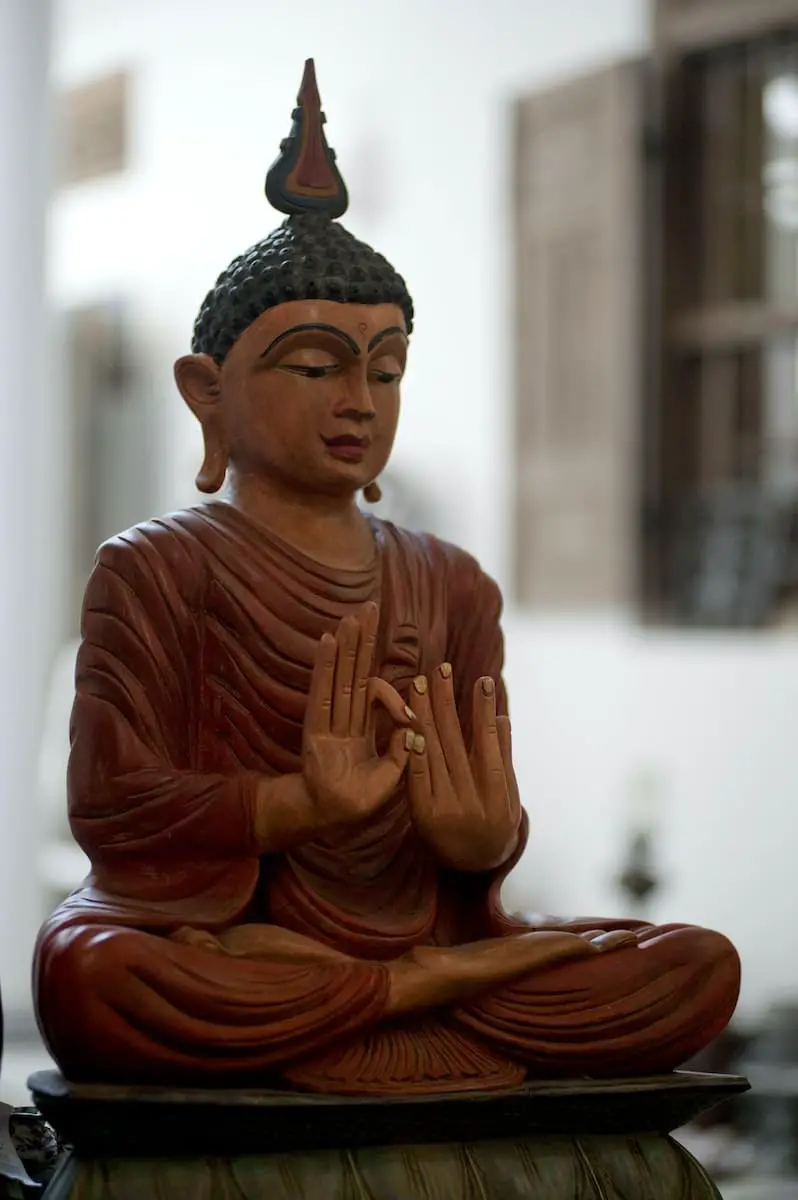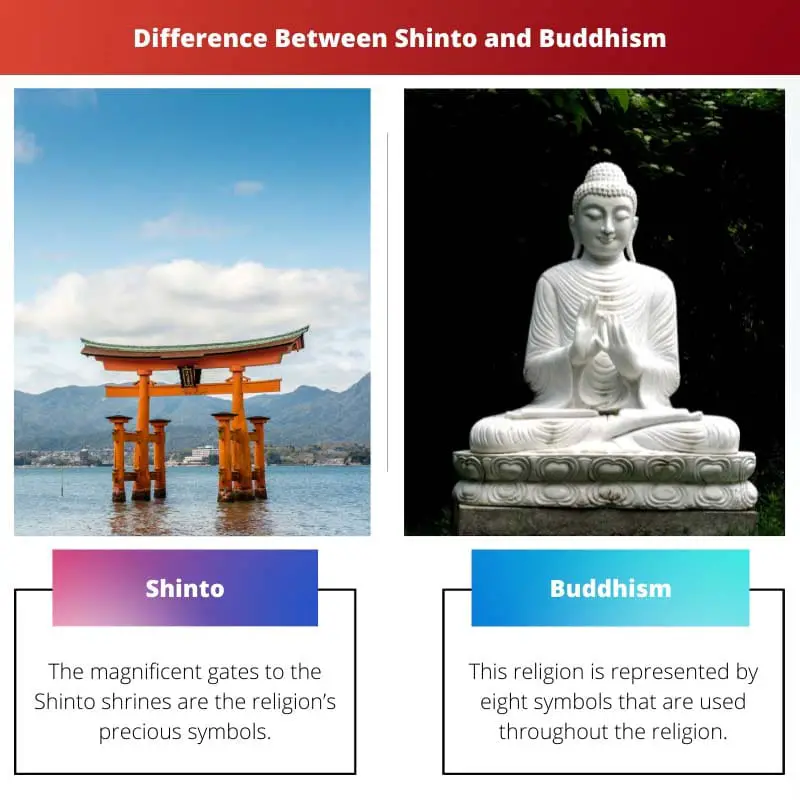The population in our global world follows different kinds of religions. Some people follow Christianity. Some follow Hinduism, some follow Islamism, some follow Jainism, and others follow Sikhism.
Other than these, there are two other religions followed: Shinto and Buddhism. Both religions are quite different in their beliefs and sentiments.
Key Takeaways
- Shinto is an indigenous Japanese religion emphasizing nature worship, while Buddhism originated in India and teaches the path to enlightenment.
- Shinto practices focus on rituals and ceremonies to connect with kami (spirits), while Buddhism emphasizes meditation, mindfulness, and moral conduct.
- Shinto has no founder or sacred texts, while Buddhism was founded by Siddhartha Gautama (Buddha) and has numerous sacred texts.
Shinto vs Buddhism
Shinto is a polytheistic and animistic religion indigenous to Japan, involving the worship of kami (spirits associated with natural phenomena). Buddhism is a religion and philosophy that originated in India, centered on the pursuit of enlightenment through meditation and ethical living.

Shinto directs to “Kami, ” a divine or sacred power. The magnificent religion initially originated in Japan. It was first practised in the Eastern part of Asia.
The religion’s practitioners (also named Shintoists by several scholars) refer to Shinto as Japan’s indigenous religion. It was recognized in the 6th century AD.
Buddhism was first practised in India (the northeastern part of India). Buddha established it and preached wisdom, meditation, knowledge, and respectful behaviour to gain enlightenment.
Buddha’s full name is Siddhartha Gautama. He was a great religious leader who worked for the enlightenment of people. It was established in the 6th century BC.
Comparison Table
| Parameters Of Comparison | Shinto | Buddhism |
|---|---|---|
| Symbol | The magnificent gates to the Shinto shrines are the religion’s precious symbols. | This religion is represented by eight characters that are used throughout the faith. |
| Festivals | Shinto celebrates the following festivals: •Ali Matsuri •Shichigosan •Seijin Shiki | Buddhism celebrates the following festivals: Buddha Purnima Punakha Tsheckhu Paro Tsheckhu |
| Belief | The religion believes in many Vida and divine power. | It includes the four noble truths and the eightfold noble path. |
| Meaning Of The Name | Shinto refers to “the way of kami”. Kami means a divine or sacred power. | Buddhism refers to the path of wisdom, knowledge, and enlightenment. |
| Country | Japan was the first country to witness the birth of Shintoism. | Buddhism was established or originated in the northeastern part of India. |
What is Shinto?
Shinto initially originated in Japan. The religion neither has a founder nor a script. It was founded in the late 6th century AD. Shintoism is practised by several practitioners ( referred to as Shintoists by scholars in rare cases).
There are several beliefs of Shintoism. These are:
- Worshipping the divine and enormous power of kami.
- Protection from evil forces by praying, offerings, and purification.
- Affinity and affection towards nature.
- Taking care of natural things and being grateful for their prosperity.
- The follower is required to follow the ten precepts of the religion.
Shinto signifies the meaning of kami, which means divine or sacred power. It is practised in shrines (private shrines, public shrines, or family shrines). Priests (also called kanzashi) perform several religious practices in these shrines.
The word “Kami” holds immense significance and importance in Shintoism. According to several religious leaders, kami resides in physical objects or places.
Physical objects like mirrors, beads, swords, stones, and places like waterfalls contain kami. Classes and objects containing kami are referred to as shintai.
The name of a few gods of Shinto are:
- Ebisu
- Izanami
- Ninigi
- Inari Okami
- Amaterasu
- Izanagi
- Hoori
- Watatsumi
- Daruma
- Jurojin

What is Buddhism?
Buddhism is one of the most popular and widely followed religions worldwide. It was founded by Buddha (King Siddhartha) in the late 6th century BC.
The religion was initially established in southern Asia but later travelled to other parts of Asia (like Japan, Korea, and China).
This religion follows five essential rules. All followers need to abide by the rules. These rules are:
- To not commit murder.
- To not steal from others.
- To not lie.
- To not use intoxicants.
- To not practice adultery.
Many Pilgrims majorly celebrate Buddhism. Devotees visit pilgrims to pray. There are four significant pilgrims where Buddhism is practised: Sarnath, Lumbini, Bodh Gaya, and Kushinagar.
There are some beliefs followed by Buddhism that are:
- Not to consume intoxicants.
- Refrain from killing or taking other’s life.
- Not to speak the wrong speech or words.
- Not to take things that are not given (that refers to stealing).
- Be mindful and knowledgeable.
Buddhism offers three central teachings that are:
- The three Universal Truths
- The Noble Eightfold Path
- The Four Noble Truths
Buddhism strongly believes in karma. It follows the motto “What Goes Around Comes Around”. The religion is studied in either Sanskrit or Pali.

Main Differences Between Shinto and Buddhism
- Shinto was initially founded in Japan while on the other hand, Buddhism was launched in India.
- Shinto doesn’t have a founder, whereas Buddha founded Buddhism.
- Shinto was established in the late 6th century AD while on other, while Buddhism was established in the late 6th century BC.
- Shintoism refers to “the way of kami”, while on the other hand, Buddhism refers to “nirvana” or “enlightenment”.
- Izanagi, Ebisu, Amaterasu, Hoori, and Hare of Inaba are a few of the Shinto gods. On the other hand, Tara, Gautama Buddha, Maitreya, Bodhisattva, and Manjusri are a few well-known Buddhist gods.

- https://books.google.com/books/about/Shinto_the_Kami_Way.html?id=aALRAgAAQBAJ
- https://books.google.com/books/about/The_Foundations_of_Buddhism.html?id=FUwSDAAAQBAJ



